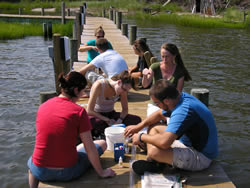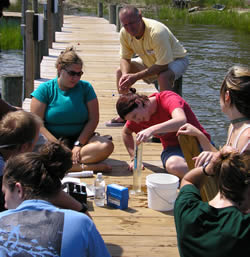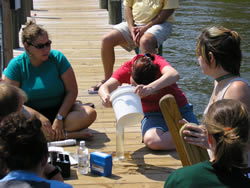Stars and STEM Stories
Sound to Sea Program Educates Student Scientists through GLOBE Protocols
For thirteen years GLOBE Partner Sidney Post has worked closely with the Sound to Sea program in North Carolina to integrate GLOBE protocols into the program's backbone, leading to a wealth of information for students and researchers to use. His partnership, the Watershed Action Team, is responsible for recruiting GLOBE schools in the Hope Mills area of North Carolina, training GLOBE teachers, and mentoring GLOBE students in the Cape Fear River Basin.

The staff of Sound to Sea has been working together with students to add their data to the GLOBE database since 1999. Instructors and students test the water quality of the sound and enter the data into the GLOBE database; they then analyze and use this information to teach students the need for good water quality. They demonstrate how the characteristics of water, including salinity, dissolved oxygen, phosphates, pH, and water transparency (turbidity), affect the ecosystem within it. By accessing data they have submitted to GLOBE they quickly learn how their findings are an important part of an on-going investigation into global change. They discover how scientists all over the world are using their data to measure the global effects of things like deforestation, El Niño and La Niña. Sound to Sea uses GLOBE to help students connect the impact of upland activities to the quality of water in estuarine systems, teaching those students about their role in protecting the watershed.

Located at Pine Knoll Shores, North Carolina, the Sound to Sea program is a non-profit organization hosted at Trinity Center. Trinity Center encompasses sixty-two acres of salt marsh, maritime forest, freshwater ponds, sand dunes, and one-third of a mile each of sound (sea or ocean inlet larger than a bay) and beachfront, making the area an ideal location for Sound to Sea. Utilizing in-depth classes and hands-on activities, the instructors of Sound to Sea teach students about the ecosystems of Bogue Banks and how human interaction affects them. Students who visit the Sound to Sea Environmental Education program have the unique opportunity to study and explore a barrier island ecosystem. During their three-day stay, students attend hands-on classes in each of the five habitats found on a barrier island. They visit the beach and maritime forest to study the plant and animal life surviving there. They also perform a freshwater pond study to look at macroinvertebrates and fish that live in that habitat.

When the three-day camp is over, students usually have to complete a project based on their findings. Projects have ranged from writing in creative journals to science experiments and reports. According to Ms. Furrer, many students call and email the Sound to Sea program with follow up questions. When a school leaves the Sound to Sea program they are given a packet of information to help them keep learning when they return to school. This packet includes information about the GLOBE Program, food waste, water usage, and helpful websites.
Through this unique partnership, the GLOBE Program and Sound to Sea program achieve mutually desired outcomes by combining a hands-on research platform with a physical at-sea laboratory.
Read more about GLOBE Student Activities in North Carolina:
- Students Get Their Hands Wet for World Water Day 2010
- GLOBE Students Battle Pollution and Join the 2010 Live Earth Run for Water
Read more about ocean hydrology research in the 2011 Ocean for Life Field Study:
04/13/2012





